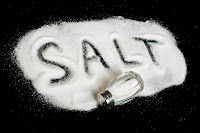Danger Zone & Food Safety
Based on many of the postings and comments recently, I’d like to discuss a few aspects food safety as it relates to temperature-limited cooking.
The Danger Zone: At some point in history, the federal government introduced the term to indicate a temperature range in which food could only sit for a maximum amount of time. The actual range has varied over time and enforcement agency, but usually in the range of about 40°F on the low end to 135 or 140°F on the high end. Exposure time is the sum of total time in the zone. This is usually stated as 4 hours for everything except raw seafood and 2 hours for raw seafood. Thus, if it takes you an hour from when you lift a piece of meat from the meat case in the market until you place it in your refrigerator, two more hours while you temper the meat on your counter before cooking, and then two hours cooking at 129°F in a water bath, the meat is considered unfit for consumption because it was in the danger zone for five hours, one more than allowable. Technically, the total time the meat was in the danger zone during processing, packaging, and shipping should also be accounted for. This argument assumes that the core temperature and surface temperature of the meat are equal, and both change instantly to match the temperature of the environment. Neither circumstance matches reality.
Maximum bacterial growth happens at 107°F. The four hour limit is based on this temperature. To simplify the issue for the public health inspectors, some wise bureaucrat decided to create a zone and consider bacterial growth equal across the entire zone. They assume that bacterial growth outside the range is safe and as soon as the meat temperature crosses into the zone, the growth hits the maximum. In other words, if the lower limit is 41°F, at 40°F, the growth is safe, but at 41°F, the growth is at a maximum. It doesn’t take much to see that this simplification is ridiculous. The first chart (lifted from the excellent chapter on food safety from “Modernist Cuisine”) plots the time it takes to achieve the same bacterial growth versus holding temperature. From the plot, it is easy to see that the time limit at 41°F is measured in weeks not hours.
The Danger Zone also assumes that the food is contaminated with bacteria and any packaging is faulty. This also comes into play when chilling cooked items. In a restaurant, it is not uncommon to see hot food force chilled to shorten the time in the danger zone, even though all bacteria has been killed by the cooking process.
Pasteurization: This is the process described by Louis Pasteur in the 19th century to kill bacteria in wine and beer. Most bacteria die instantly around 160°F. For example, for effective pasteurization, milk can be heated up to 145°F for 30 minutes, but this method isn’t very common. More common is heating milk up to at least 161.6°F for 15 seconds, which is known as High-temperature Short-Time (HTST) pasteurization, or flash pasteurization. Given sufficient time, milk can be pasteurized at much lower temperatures than 145°F. The takeaway here is first that only bacteria are killed. Germs require much higher temperatures not achievable in water-based systems at normal atmospheric pressure. Second, the temperature to kill bacteria is time dependent. Please note that the cooking temperatures and times in the Joule application make no claims about pasteurization. If you are concerned with killing possible bacteria during low temperature cooking, than a more sophisticate application such as SousVide Dash (http://tinyurl.com/y7xzbbsk) is required.
Bacteria: The bacteria usually of concern to cooks are salmonella, listeria, and E. choli. All three are airborne. They do not naturally occur on the interior of meat or fish. This is why it is considered safe to cook meat to a temperature below HSS guidelines as long as the exterior is heated to a high enough temperature to kill the bacteria on the surface. This is also why ground or glued meat requires a higher cooking temperature and or longer cooking time than solid meat. The FDA Food Guide has long included a chart showing that a logarithmically longer holding time was required as the endpoint cooking temperature decreases from 160°F. In general, a reduction of one thousand to one, sometimes called a log reduction of 3, is sufficient for serving to a normal, healthy population. For an immunocompromised population, a log reduction of 6, or one million to one, is required. Different bacteria have slightly different requirements. The higher the desired cooked temperature of the food item, the easier it becomes to pasteurize the food completely before the cooking is finished. Conversely, if a lower endpoint temperature is desired, such as for a rare steak or many seafood preparations, the harder it becomes to pasteurize the food completely before desired core temperature is reached. In many cases, if the temperature is too low or the time too long, an effective bacterial kill cannot be predicted.
By way of example, let’s look at the one-inch thick top sirloin steak I prepared for dinner tonight. The Joule application suggested a cooking time of 1 hour at 129°F. For the same temperature, the SousVide Dash application recommended almost 4 hours! In reality, it took the steak’s core just shy of 2 hours to reach a temperature of 128.9°F and another two hours to increase the last tenth of a degree. At 1 hour, the Joule-recommended cooking time, the steak’s core temperature did exceed 128°F. As can be seen in the second chart, bacterial kills of various amounts and locations were achieved at various times between about 90 minutes and 4 hours. In reality, I got delayed and the steak cooked for abut 5 hours. It was both tasty and tender.



Comments
Post a Comment